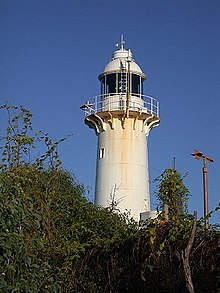Cape Leveque

 | |
 | |
| Location | Cape Leveque at the northern edge of the Dampier Peninsula in Western Australia |
|---|---|
| Coordinates | 16°23′41″S 122°55′41″E / 16.3947°S 122.92797°E |
| Tower | |
| Constructed | 9 August 1911 |
| Construction | prefabricated cast iron |
| Height | 13.3 m (44 ft) |
| Shape | conical frustum tower with balcony and lantern[1] |
| Markings | white (tower), white (lantern) |
| Operator | Kooljaman Aboriginal Community |
| Heritage | State Registered Place |
| Light | |
| Focal height | 43 m (141 ft) |
| Characteristic | Fl(3) W 20s |
Cape Leveque is at the northernmost tip of the Dampier Peninsula in the Kimberley region of Western Australia. Cape Leveque is 240 kilometres (150 mi) (via the Cape Leveque Road) north of Broome, and is remote with few facilities. Nevertheless, the Cape's sandy beaches are attracting an increasing number of visitors.

The 13.3-metre-tall (44 ft) lighthouse was commissioned at Cape Leveque on 9 August 1911.[2][3] Its light characteristic is a group of three flashes that occurs every twenty seconds whereby the light source emits from a focal plane of 43 metres (141 ft).[4]: 24–25 [5] The lighthouse marks the western entrance of King Sound.
Cape Leveque was a camping ground for ancient nomadic people of northern Australia and is probably still being used today. Their huge middens overshadow the small caravan park resting on the shores of the Indian Ocean. Wild turtles and a multitude of sea birds nest on the shores and collect seafood off the exposed rocks at low tide along the shore down the coast to Broome in the southern part of the peninsula. Humpback whales come to give birth in the area, and rest and play among the sheltered islands off the Dampier Peninsula.
The traditional owners of the area are the Bardi people.[6]
William Dampier's description from Cygnet off Cape Leveque on 5 January 1688 reads: "This part is all a low, even land with sandy banks against the sea ... the points rocky and so are some of the islands in the bay... The soil is dry and sandy, destitute of water, except you make wells, yet producing divers sorts of trees."[7]
In January 2015, the locality recorded rainfall in excess of 400 mm (16 in).[8]
See also
[edit]References
[edit]- ^ "Cape Leveque Lighthouse Vertical Section of Lantern 8' 9 3/4" diameter at Glazing". National Archives of Australia. Commonwealth of Australia. 2019. Retrieved 20 May 2019.
- ^ Heritage Council (1 July 2017). "Cape Leveque Lighthouse". State Heritage Office. Government of Western Australia. Retrieved 19 May 2019.
- ^ "AMSA Heritage strategy 2018". Australian Maritime Safety Authority. Australian Government. 16 August 2018. Retrieved 20 May 2019.
- ^ Cumming, D.A.; Glasson, M.; McCarthy, M. (November 1995). "Lighthouses on the Western Australian coast and off-shore islands" (PDF). Department of Marine Archaeology. Western Australian Maritime Museum. Retrieved 20 May 2019.
- ^ Rowlett, Russ (22 April 2009). "Lighthouses of Australia: Western Australia". The Lighthouse Directory. University of North Carolina at Chapel Hill. Retrieved 27 April 2009.
- ^ "Ausanthrop - Australian Aboriginal tribal database". ausanthrop.net. 2012. Archived from the original on 17 August 2010. Retrieved 2015-01-10.
- ^ Lee, I., 1925. Early Explorers in Australia From the Log-Books and Journals
- ^ "Record rainfall in remote Cape Leveque on Dampier Peninsula in the Kimberley - ABC News (Australian Broadcasting Corporation)". ABC News. abc.net.au. 8 January 2015. Retrieved 10 January 2015.